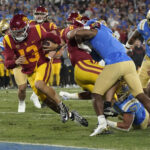The Pac-12’s existential crisis grew more dire Thursday when Colorado’s board of regents unanimously approved a return to ancestral ground. The Buffaloes will enter the Big 12 Conference, their home for more than six decades, for the start of the 2024-25 college sports season.
Colorado, which joined the Pac-12 (along with Utah) a dozen years ago, becomes the third member to depart the conference in the past 13 months after last summer’s announced exit of the Los Angeles schools, which are bound for the Big Ten.
The totality of the departures — 25 percent of the membership — heaps additional pressure on commissioner George Kliavkoff, whose two years at the helm have been arguably the rockiest in conference history. His year-long, unsuccessful (so far) pursuit of a media rights contract created the circumstances for Colorado to accept an offer from the Big 12.
Pac-12 survival depends on what happens next.
As a singular entity, Colorado’s departure will have little impact. The Buffaloes posted just one winning season in football and were a mid-level program in men’s basketball. Nor is their location viewed as a critical hub for recruiting.
But to what extent will the departure undermine collective faith in Kliavkoff’s leadership? How will the departure impact the Pac-12’s media rights negotiations? And most significantly, will Arizona, Arizona State or Utah follow the Buffaloes out the door? All three schools have drawn interest from the ultra-aggressive Big 12.
If the schools remain committed, the conference will move forward in its basic form and attempt to replace the Buffaloes by expansion.
Multiple industry sources who described Colorado as an ongoing flight risk told the Hotline that there is currently no indication Arizona, Arizona State and Utah are planning to depart.
Meanwhile, the Big Ten has shown no interest in adding Oregon or Washington, with commissioner Tony Petitti telling reporters on Wednesday that he hasn’t received “any direction” from his schools to pursue more members.
All that could change, of course, for realignment is nothing if not fluid. And the endgame depends on Kliavkoff’s ability to craft an acceptable media rights deal — the sooner the better for his constituents.
Colorado’s patience with the process wore so thin that chancellor Phil DiStefano accepted the Big 12’s offer ($31.7 million annually in media revenue) without waiting for a final proposal from the Pac-12.
Asked about the financial repercussions, one source did not view Colorado’s departure as having a material impact on the Pac-12’s media valuation or the per-school payouts.
According to an independent industry analysis provided to the Hotline, CU’s media valuation falls in the middle of the 10 remaining schools based on TV viewership data.
“The Pac-12 should beat the Big 12’s number if they play it right,” a source said.
However, the psychological impact on university presidents that results from losing a school is difficult to measure.
Several expansion options exist for the conference, which will have nine members starting in the summer of 2024. The list includes San Diego State, SMU and perhaps Colorado State, which would allow the Pac-12 to maintain a presence in the Denver market.
This much is sure: The conference wasn’t surprised by Colorado’s move the way it was by the L.A. schools’ exit in the summer of 2022.
One high-ranking source told the Hotline months ago that everyone was monitoring developments in Boulder — that Colorado was the one school that appeared “wobbly.”
Kliavkoff likely has a plan to account for the latest hole in his lineup.
Will it be good enough, and completed soon enough, to prevent more departures?
*** Send suggestions, comments and tips (confidentiality guaranteed) to pac12hotline@bayareanewsgroup.com or call 408-920-5716
*** Follow me on Twitter: @WilnerHotline
*** Pac-12 Hotline is not endorsed or sponsored by the Pac-12 Conference, and the views expressed herein do not necessarily reflect the views of the Conference.
Related posts:
 Pac-12 top 10: Grubb stays at Washington, another elite QB arrives, budget surpluses and a singular performance
Pac-12 top 10: Grubb stays at Washington, another elite QB arrives, budget surpluses and a singular performance

(AP Photo/Marcio Jose Sanchez)
Pac-12 media rights: Finish line in sight? Interpreting the latest comments from university presidents (and a notable internal development)
(AP Photo/Ralph Freso, File)
Mailbag: SMU’s fit in the Pac-12 (better than in the Big 12), SDSU’s competitive position, “chatter” about collapse and more
Southern California quarterback Caleb Williams (13) (AP Photo/Mark J. Terrill)
Wilner Hotline – Pac-12 football: Five storylines to watch Friday at the summer media showcaseJon Wilner
Jon Wilner has been covering college sports for decades and is an AP top-25 football and basketball voter as well as a Heisman Trophy voter. He was named Beat Writer of the Year in 2013 by the Football Writers Association of America for his coverage of the Pac-12, won first place for feature writing in 2016 in the Associated Press Sports Editors writing contest and is a five-time APSE honoree.
